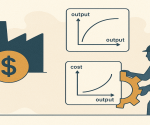Every business must spend money to make goods or services. These expenses include raw materials, wages, electricity, and other daily costs. When we add all these expenses, we get the cost of production. It means the total amount a company spends to produce goods or offer services during a given time. It helps the business find out how much it must spend before it starts earning profits. The cost of production includes fixed costs and variable costs. Fixed costs do not change even when the production increases or decreases. These include rent, interest on loans, and salaries. Variable costs change with the level of production. These include raw materials, labour wages, and fuel charges. Businesses use this cost to set prices for their products. They calculate it carefully so they do not sell at a loss. If the cost of production goes up, the price of the product also rises. If it goes down, the business may reduce prices to compete better in the market.
Meaning of Cost of Production
Cost of production means the total expenses a business makes to create goods or provide services. It includes money spent on raw materials, wages, rent, tools, and electricity. Without knowing the total cost, a business cannot decide the selling price or make profit.
This cost helps in planning and controlling business expenses. When the company knows where and how it spends money, it can make changes and save costs. It also helps in comparing different products and finding which one gives better profits.
A shopkeeper buys materials, pays workers, pays electricity bills, and rents a shop. All these expenses are needed to run the shop. Together, these are called the cost of production.
Every company wants to lower this cost without reducing quality. That way, it can sell at a good price and still make profit. When the cost goes high, the company may lose customers if prices rise too much.
- Companies track each expense carefully
- Cost of production affects profit and pricing
- Lower cost means better control and success in business
Understanding this cost helps business leaders make better decisions.

Types of Cost of Production
The cost of production includes different types of costs. These types show how much a business spends, when it spends, and how that spending changes. Knowing all types of cost helps the company manage money better.
Each type has a special use in calculation, decision-making, and planning. Managers use these to find how costs behave when production levels change or when they start a new project.
- Fixed Cost
This cost stays the same even if the business makes more or fewer goods. It includes rent, salaries, insurance, and interest. It does not change often. - Variable Cost
This cost changes when the business produces more or less. It includes raw materials, direct labour, electricity, and fuel. Higher production means higher variable costs. - Semi-Variable Cost
This cost has both fixed and variable parts. A good example is the telephone bill. One part is fixed monthly, and the other depends on use. - Direct Cost
This is directly linked to making the product. It includes raw materials, direct wages, and packaging. - Indirect Cost
This is not directly linked to one product but needed for all products. It includes office rent, cleaning staff salary, and admin costs.
Elements of Cost of Production
Elements of cost are the parts that form the total cost. These elements help to track every rupee spent in the business. The cost has three main elements: material cost, labour cost, and expenses.
Knowing each element gives a complete picture of business spending. It also helps reduce waste and improve efficiency. Businesses break these into small parts to plan better.
- Material Cost
This includes all raw materials needed to make the product. It has direct materials (main parts of the product) and indirect materials (like glue, nails, or oil used in machines). - Labour Cost
Labour cost means the wages paid to workers who help in production. It includes direct wages (workers who make goods) and indirect wages (supervisors, helpers). - Expenses
These are other costs like electricity, rent, tools, maintenance, and transportation. These are also direct or indirect depending on their link to the product.
| Element | Direct | Indirect |
| Material | Wood, metal | Grease, small tools |
| Labour | Carpenter’s wage | Foreman’s salary |
| Expenses | Machine hire | Factory cleaning |
By knowing elements clearly, businesses manage their budgets better.
How to Calculate Cost of Production
To run a business well, one must know how to calculate the cost of production. The process includes identifying all expenses, grouping them, and adding them to get the final total. The formula must include both fixed and variable costs.
Companies often use this calculation to decide pricing, plan budgets, and forecast profits. Even small mistakes in cost calculation can lead to huge losses.
- List Direct Costs
Start by writing all direct costs like raw materials and direct labour. - Add Indirect Costs
Include factory rent, admin expenses, machine repair, etc. - Use the Formula
| Cost of Production = Direct Materials + Direct Labour + Direct Expenses + Factory Overheads + Other Production Costs |
- Divide by Units Produced
If you want cost per unit, divide the total cost by the number of units made.
Example:
If a company spends ₹2,00,000 on materials, ₹1,00,000 on labour, ₹50,000 on overheads, and makes 1,000 units:
Cost of Production per unit = ₹(2,00,000 + 1,00,000 + 50,000) / 1,000 = ₹350
Knowing this cost helps set the selling price properly.
Factors Affecting Cost of Production
Several things affect how much a company spends on making products. These may be internal like worker skill or external like market rates. Businesses must understand these to control costs better.
Some of these factors change with time. Others depend on company policy or equipment used. These factors impact cost structure, pricing, and overall profitability.
- Raw Material Prices
If raw materials become expensive, cost increases. If prices fall, cost goes down. - Technology Used
Modern machines reduce waste and time, lowering the cost. Old machines may cost more. - Labour Efficiency
Skilled workers do more work in less time. That reduces labour cost. - Production Volume
Making more units reduces cost per unit. Fixed costs get divided over more products. - Government Taxes and Rules
New taxes or regulations can increase cost. Subsidies may reduce it. - Transportation and Fuel
If transport becomes costly, production cost rises.
By keeping track of these factors, companies make better decisions.
Importance of Cost of Production in Business
The cost of production plays a key role in every business activity. It affects planning, pricing, profit, and success. It also tells how well a business manages its resources.
If a company does not track costs well, it may face losses even if sales are high. Knowing this cost helps owners improve operations and increase profit.
- Helps Set Price
The cost decides the lowest price at which a product can be sold. It prevents loss. - Improves Budget Planning
Companies can make monthly and yearly plans better when they know the production cost. - Increases Profit Margin
Lower cost means higher profit if prices remain the same. - Helps Compare Products
If a company makes more than one product, it can find which one gives more profit. - Supports Cost Control
Managers can find where the money is being wasted and fix it.
Cost of production is the backbone of all financial decisions.
Difference Between Cost of Production and Cost of Goods Sold
Many students and new business owners confuse cost of production with cost of goods sold. They look similar but are not the same. One shows the cost to make goods. The other shows cost after selling.
Knowing the difference helps in clear reporting and accounting. It also helps in setting final prices and profits.
| Basis | Cost of Production | Cost of Goods Sold (COGS) |
| Definition | Cost to make the product | Cost of product sold to customers |
| Includes | Direct and indirect production costs | Only cost of items sold |
| Inventory | Includes finished goods left | Includes only sold goods |
| Use | For planning and pricing | For calculating gross profit |
A good business tracks both costs for better control and analysis.
Cost of Production FAQs
Q1. What is the cost of production in simple words?
It is the total money a business spends to make goods or services.
Q2. What are the types of cost of production?
They include fixed cost, variable cost, direct cost, indirect cost, and semi-variable cost.
Q3. What are the main elements of cost of production?
Material cost, labour cost, and expenses are the three main elements.
Q4. Why should a business calculate the cost of production?
It helps in setting prices, making profits, and planning budgets.
Q5. What factors affect the cost of production?
Raw material prices, technology, labour skills, and government rules affect cost.
Q6. How is the cost of production different from the cost of goods sold?
Cost of production includes unsold goods. COGS includes only sold items.


